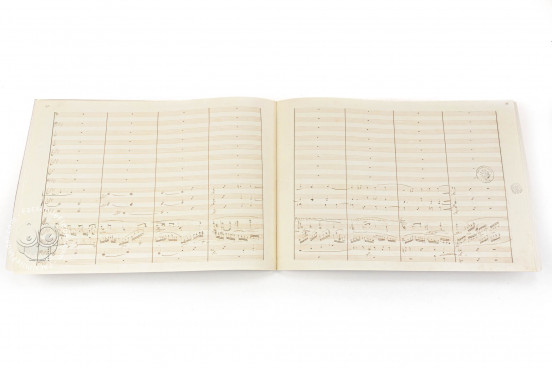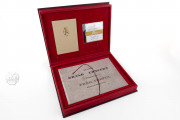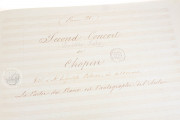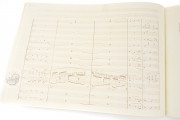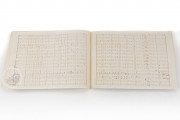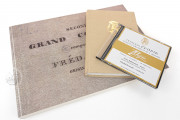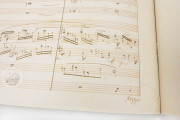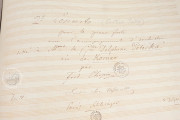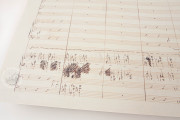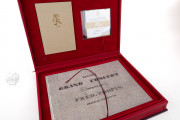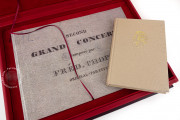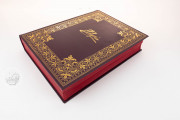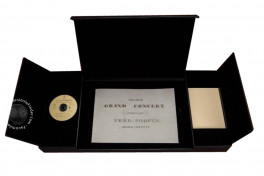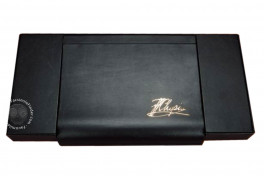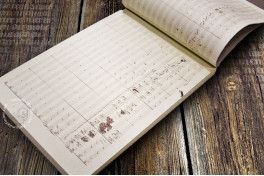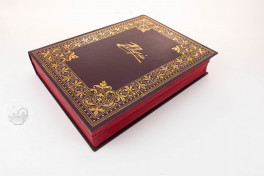A very young composer
The work was created between October 1829 and February 1830, when Chopin was around 20 years old. The full name of the piece is Piano Concerto No. 2 in F minor, Op. 21, indicating that this is Chopin’s twenty-first composition (from the Latin opus – work). The first composer to use this designation was Biagio Marini in 1617, while Ludwig van Beethoven was the first to employ the opus number in a systematic manner.
Although Chopin’s Concerto in F minor was composed before the Concerto in E minor (both in the same year), it is referred to as the second due to its higher opus number.
The first concerts after completing his musical studies
The Concerto in E minor was published in 1833 in Paris and Leipzig, whereas the F minor concerto was published only in 1836. Both concertos are the first significant pieces composed by Chopin after he completed his musical studies. They were initially presented in Chopin's sitting room in the Krasinski Palace (orchestral parts were later arranged for chamber ensembles) to the elite of musical Warsaw and to the composer’s closest friends and family, before being performed for a broader audience at the National Theatre in Warsaw. The rehearsal in the sitting room was held on March 3, 1830, followed by the long-awaited premiere (a sell-out by all accounts) of the Concerto in F minor on March 17, 1830. The solo parts were played by the composer himself, and the orchestra was directed by Karol Kurpinski.
The concert was met with an enthusiastic reception from both the audience and critics alike. Maurycy Mochnacki wrote in the Polish Courier: "The adagio in Mr. Chopin’s concert is a unique work of an extraordinary musical genius. [...] Indeed! He who starts so young will make his name known far and wide."
The second concert was held at the National Theatre on March 22, 1830. During the performance of the Concerto in F minor, Chopin was displeased with the tone of the piano and decided to change instruments. The new piano, which fully satisfied the composer, was provided by a Russian general, Diakov. During the second concert, in addition to the aforementioned piece, Chopin also played Rondo à la Krakowiak and improvised during the encores. The artist was strongly urged to give a third concert but was busy working on new pieces and fatigued by the praise, which he considered exaggerated.
Chopin's brilliant composition
The Concerto in F minor was composed in accordance with the conventions of the genre introduced by Mozart, though it was directly influenced by Johann Nepomuk Hummel, known for the "brillant" style. This style of piano music was popular in the first half of the 19th century. However, in both of his concertos, Chopin elevated this style to its apogee, infusing it with a new, romantic dimension.
The concerto is divided into three movements: I Maestoso in F minor, II Larghetto in a key relative to F minor, i.e., A-flat, and III Allegro vivace in F minor. The first movement is structured as a sonata with double exposition—the piece is first presented by the orchestra, followed by a more elaborate solo performance. The second movement, which is a nocturne, plays a significant role in the composition. The finale, played as a rondo, features motives inspired by Polish folk dances, incorporating elements of the mazurek and kujawiak. In the third movement, the violin plays col legno (striking the string with the stick of the bow) while accompanying the piano, which plays the melody of the mazurka. Some accuse the composer of failing to achieve a balance between the orchestral part and the solo piano part, which is slightly longer. However, it is important to remember that Frederic was just shy of 21 years old at the time and had no prior experience with an orchestra. Nevertheless, the sheer excellence of the piano part more than compensates for this imbalance—a fact attested by the reality that virtually every significant pianist includes this concerto in their repertoire.
A Real Romantic Piece
Chopin’s piece became the starting point for the romantic concerto. As Chopin openly admitted in his letters to his friend Tytus Woyciechowski, this piece was inspired by his feelings for Konstancja Gladkowska, a singer.
"Because I, maybe luckily, already have my ideal, whom I faithfully, though silently, have been serving for the last six months, whom I dream of, and in whose memory I have composed the adagio for my Concerto..." — this is what the composer wrote in his letter to his friend on October 3, 1829.
Konstancja met Chopin on April 21, 1829, during a concert of the soloists of the Warsaw Conservatory, where she was learning to sing under the tutelage of Carlo Soliva. She was Chopin’s first love, though their relationship lasted only 18 months and ended after Chopin left for Paris; she and Chopin corresponded for another year before ultimately losing all contact.
The Concerto in F minor, published only in 1836, was dedicated to Delfina Potocka, as indicated in the presented edition autograph from 1830. Delfina Potocka, dubbed the muse of Polish romanticism, was a long-time friend of Chopin. She met him in Dresden in 1830, probably in her mother’s house, and in 1832, she settled in Paris, where she became a pupil of the composer. Their close relationship often fueled gossip regarding their alleged love affair — in the mid-20th century, love letters were even manufactured to support this claim.
Chopin’s Only Semi-Autograph
The presented work was preceded by a draft made on grey-green paper with 14 staves per page and text on the first four staves. It contains several bars of the solo figuration and a few bars of the piano transcription of the orchestral part.
The concerto in question was commemorated by Chopin himself on a semi-autograph in 1830, before it was officially printed. It was partially written down by the composer and partially by an unknown copyist. The great Polish artist wrote down the solo part, the piano transcription, and the title page: 2d Concerto. / pour le pianoforté / avec l’accompagnement d’orchestre / dediés à Mme la Csse Delphine Potocka / née de Komar / par / Fred. Chopin / Op. 21. / Paris Schlesinger, which translates to "Second piano concerto with orchestra accompaniment, dedicated to Countess Delfina Potocka née Komar, by Frederic Chopin, opus 21, Paris Schlesinger." The Schlesingers ran a publishing house in Paris; the semi-autograph was intended for this publisher, but over time it became the property of the Breitkopf & Härtel publishing house in Leipzig, hence the numerous black and round seals from its German archive. The semi-autograph was written on cream-colored vat paper with a watermark produced by the French Blacons paper mill, with 16 staves per page. It has 87 leaves, or 72 pages. This manuscript is Chopin’s only semi-autograph of that size and such musical significance.
Through The Tough Times
The Concerto in F minor made its way to the collection of the National Library at the beginning of 1938 when it was donated by the Ministry of Denominations and Public Enlightenment, along with a collection of Chopin’s other autographs and copies. The entire collection was purchased by the Polish government in 1937 from Breitkopf & Härtel. In September 1939, during the German offensive, Polish citizens, taught by the bitter experience of the Swedish Deluge (to this day, Swedish churches and museums are adorned with Polish works of art), took the valuable manuscript, along with the entire collection of Chopin’s works, out of Poland. The collection was first moved to London, the seat of the Polish government in exile, and then to Canada, where it was safely stored in a branch of the Bank of Montreal in Ottawa. The semi-autograph of the Concerto in F minor returned to Poland only in 1959, twenty years after it had left the country. It is currently stored in the collection of musical manuscripts of the National Library, alongside 20 other autographs and editions of Frederic Chopin. Unfortunately, other manuscripts of the composer were irretrievably lost or destroyed during the war.
We have 3 facsimiles of the manuscript "Frédéric Chopin - Concerto in f-minor":
- Fryderyk Chopin, Piano Concerto No.2, in F minor, Op.21 facsimile edition published by Maruzen-Yushodo Co. Ltd., 2005
- Fryderyk Chopin - Koncert f-moll facsimile edition published by Orbis Pictus, 2005
- Fryderyk Chopin - Koncert f-moll facsimile edition published by Bernardinum Wydawnictwo, 2005

